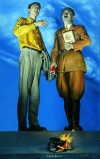
Illustration:
ill. 5.27 a (set: 5.27)
Author:
Wang Xingwei (1969 -) 王兴伟
Date:
1995
Genre:
oil painting
Material:
scan, paper, colour; original source: oil on canvas, 200 x 155 cm
Source:
Wang Xingwei, The Oriental Way, 1995 (DACHS 2009 Wang Xingwei Going to Anyuan), Heidelberg catalogue entry
Courtesy:
Wang Xingwei, Galerie Urs Meile, Beijing-Lucerne
Keywords:
Mao goes to Anyuan, China Avant-Garde, Mao portrait, parody
Wang Xingwei: The Oriental Way (Wang Xingwei: Dongfang zhi lu 王兴伟: 东方之路)
Self-reflection turned into reflections about Mao and his importance to the reflecting self is the topic of Wang Xingwei’s 王兴伟 (1969-) painting 东方之路 The Eastern/Oriental Way from 1995 as well. It shows a sleek businessman on a “Journey South” 南巡—which Deng Xiaoping had taken just a few years before the painting was conceived, in 1992, to support more expansionist economic policies. The young man, a double of the artist, who recurs in a number of enigmatic paintings from the same year, appears here in Mao’s stead: dressed in shiny ocre suit and tacky yellow shirt, he is added to a background which is a rather accurate copy of Liu Chunhua’s famous model painting Chairnman Chairman Mao goes to Anyuan. The image thus cites a paradigmatic vision of Mao without showing Mao: the clouds above the young man in yellow and the majestic mountainscape at his feet are exactly the same as in the original. The young man who has been cast in Mao’s position holds, characteristically, the peculiar (here pinkish) umbrella in his hands (which, if read in conjunction with another image from this series, appears to be made of pink plastic, however, no longer of paper as in the hands of the “original” Mao portrait, see ill. 5.27 c). Yet this young man has turned away from Anyuan, he walks the other way, perhaps he even decides to “go global” 走出去, a policy which drew on the experiences of Deng’s Southern Tour, had been practiced since the mid 1990s to be officially implemented in 1999 (Jungbluth 2011). Here, as in the other pictures of the series, Wang establishes visual parallels with well-known artistic themes, materials and gestures and thus creates, especially through the many subtle interconnections within the series, a rather complex set of associations.












































































































